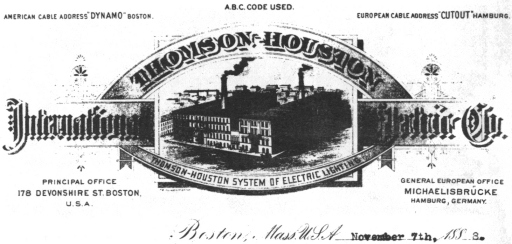Thomson-Houston
Reprinted from "INSULATORS - Crown Jewels of the Wire", January 1984, page 24
Mr. W. F. Endress,
Havana, Cuba.
Dear Sir:-
In regard to the
matter of danger from overhead wires, would say that we recommend to your
careful perusal the July 7th issue of the "Electrical Review" which we
send you today. This contains an admirable address by Prof. Anthony to the
members of the Electrical Club of New York, and the subject of danger is treated
in an unprejudiced and common sense way.

At the present time there is no
electric manufacturing company that has more sub-companies using its system of
lighting than the Thomson-Houston Company. In the United States alone there are
over three hundred and fifty cities and towns using our system of Arc and
Incandescent lighting. We have over 45,000 Arc lights and thousands of
Incandescent lights burning every night in the United States, and in nearly all
of these plants the wires are run overhead. Wherever the wires have been
placed underground, it has been from the motive of convenience rather than
necessity and certainly not from any motive of apprehended danger. The other
night the man-hole of an Edison sub-way conduit in Boston had its cover blown
off and thrown dangerously high in the street. It is supposed that the burning
of some fuse ignited a portion of sewer gas which had collected in the man-hole.
However this may be, it is only one instance to show that there is a certain
amount of danger connected with every form of public service, and no more
accidents have occurred from electric wires, either overhead or underground,
than from the legitimate use of any of our modern conveniences which you might
name.
In some of the larger cities the question of placing the wires underground
has been proposed but it has been brought forward in every instance by the vast
number of wires in use already for telegraph, telephone, fire alarm, messenger
boy, police signal, and other public services rather than on account of the
electric lighting companies, and certainly not on account of the danger from
electric lighting wires. Some of the foremost scientific experts in the Country
unhesitatingly give their approval to overhead wires and at a recent hearing
before the Town Council of Newton, Mass., Prof. Silas W. Holman of the Mass.
Institute of Technology stated that he had introduced the electric light into
his house, regarding it as perfectly safe, healthy, and agreeable. In the City
of Boston, electric lighting wires are all overhead, that is to say, on poles or
roofs, and there are burning nightly in Boston over 3000 Arc lights and 10,000
Incandescents. In Havana, as has been proposed for some of our Northern Cities,
it would be perfectly practicable to appoint a City Inspector who should make
rigid rules regarding the Light System, as well as for systems of public sewerage, water supply, etc; but you will, of course, impress upon the parties with
whom you are dealing the fact that all the workmen in the employ of our company
are thoroughly schooled in the requirements of the business, and in the
management and care of electric lighting apparatus. Impress upon them the
necessity of keeping overhead lines in good condition and in neat order, for the
good of the lighting company itself, as far as the efficiency of the service
is concerned, as well as for the benefit of the public at large. When the United
States cities have so many services of public distribution by wires to look
after that there is no room for them, then they will begin to put the wires down
under ground. In that case, the wires for telegraph and telephone will go first,
because they can be safely operated under ground; but the electric light wires
will be left to their proper place in the air until a medium equally efficient
and safe can be provided under ground.
Yours very truly,
THOMSON-HOUSTON
INTERNATIONAL ELECTRIC CO.
(signed .... Davenport)
|
